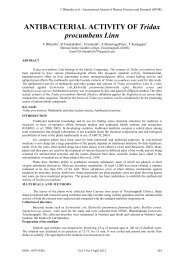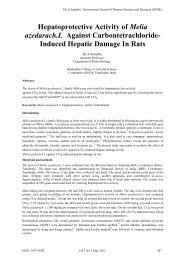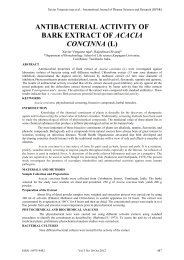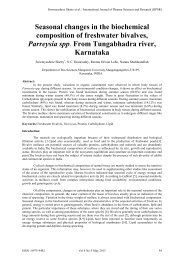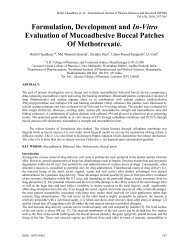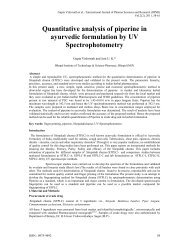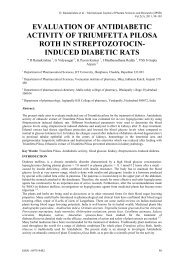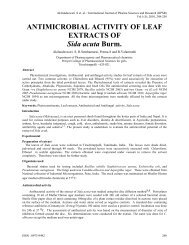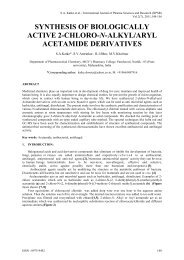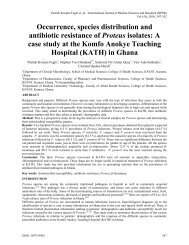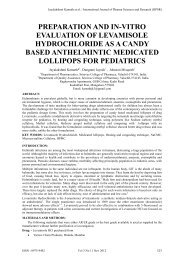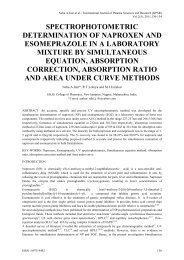Immunomodulatory Activity of Abutilon Indicum linn on Albino Mice
Immunomodulatory Activity of Abutilon Indicum linn on Albino Mice
Immunomodulatory Activity of Abutilon Indicum linn on Albino Mice
You also want an ePaper? Increase the reach of your titles
YUMPU automatically turns print PDFs into web optimized ePapers that Google loves.
N.L. DASHPUTRE et. al. / Internati<strong>on</strong>al Journal <str<strong>on</strong>g>of</str<strong>on</strong>g> Pharma Sciences and Research (IJPSR)<br />
Vol.1(3), 2010, 178-184<br />
Animals<br />
Inbred col<strong>on</strong>y <str<strong>on</strong>g>of</str<strong>on</strong>g> swiss albino mice <str<strong>on</strong>g>of</str<strong>on</strong>g> weighing between 20-25 gm were housed in groups <str<strong>on</strong>g>of</str<strong>on</strong>g> 5 to 6. All mice<br />
were fed with pelleted diet (Pranav Agro Industries Ltd, Sangli, India) and tap water ad libitum. Instituti<strong>on</strong>al<br />
Animals Ethics Committee (IAEC) approved the experimental protocol and care <str<strong>on</strong>g>of</str<strong>on</strong>g> animals was taken as per<br />
guidelines <str<strong>on</strong>g>of</str<strong>on</strong>g> CPCSEA, Department <str<strong>on</strong>g>of</str<strong>on</strong>g> Animal Welfare, and Government <str<strong>on</strong>g>of</str<strong>on</strong>g> India. (843/ac/04/ CPCSEA).<br />
Drugs and chemicals<br />
All the drugs and chemicals were <str<strong>on</strong>g>of</str<strong>on</strong>g> analytical grade while the other drugs were procured from Levamisole<br />
(Khandelwal Pharmaceutical Ltd. Mumbai), Cyclophosphamide (Biochem pharmaceutical, Mumbai), Colloidal<br />
carb<strong>on</strong> (Indian ink, camel India Pvt. Ltd.).<br />
Test compound formulati<strong>on</strong>s<br />
The diluti<strong>on</strong> <str<strong>on</strong>g>of</str<strong>on</strong>g> aqueous extract <str<strong>on</strong>g>of</str<strong>on</strong>g> leaves <str<strong>on</strong>g>of</str<strong>on</strong>g> AI (AEAI) was prepared in distilled water and the aqueous<br />
suspensi<strong>on</strong> <str<strong>on</strong>g>of</str<strong>on</strong>g> ethanolic extract <str<strong>on</strong>g>of</str<strong>on</strong>g> leaves <str<strong>on</strong>g>of</str<strong>on</strong>g> AI (EEAI) was prepared in 0.5 % carboxymethylcellulose (CMC)<br />
soluti<strong>on</strong> in distilled water prior to oral administrati<strong>on</strong> to animals. It was used within 7 days and stored at 8 0 C<br />
while for further use, freshly prepared soluti<strong>on</strong> was used. The vehicle al<strong>on</strong>e served as c<strong>on</strong>trol.<br />
Acute toxicity studies<br />
Acute toxicity studies were performed according to organizati<strong>on</strong> for ec<strong>on</strong>omic cooperati<strong>on</strong> and development<br />
(OECD) guidelines, received draft guidelines 425, received from CPCSEA, Ministry <str<strong>on</strong>g>of</str<strong>on</strong>g> social justice and<br />
empowerment, Government <str<strong>on</strong>g>of</str<strong>on</strong>g> India. [10] <strong>Mice</strong> weighing between 20-25 gm in groups <str<strong>on</strong>g>of</str<strong>on</strong>g> five were used (n=5).<br />
The animals were fasted for 4 hr. with free access to water <strong>on</strong>ly. The both EEAI and AEAI extracts was<br />
administered orally in doses <str<strong>on</strong>g>of</str<strong>on</strong>g> 2000 and 5000 mg/kg to different groups <str<strong>on</strong>g>of</str<strong>on</strong>g> mice and observed over 14 days for<br />
mortality and physical/behavioral changes. The experiments were performed after the experimental protocols<br />
had been approved by the Instituti<strong>on</strong>al Animal Ethical committee.<br />
Thin layer chromatography<br />
TLC studies were carried out <strong>on</strong> the EEAI for flav<strong>on</strong>oids, using silica gel G TLC plates as the stati<strong>on</strong>ary phase<br />
and Chlor<str<strong>on</strong>g>of</str<strong>on</strong>g>orm : benzene : Ethanol : acetic acid : water (11 : 4 : 2 : 1 : 2 ) as the mobile phase. The TLC plates<br />
were spotted using the glass capillary and developed by spraying with ninhydrin reagent resulted in the<br />
formati<strong>on</strong> <str<strong>on</strong>g>of</str<strong>on</strong>g> bright yellow spot indicating the presence <str<strong>on</strong>g>of</str<strong>on</strong>g> flav<strong>on</strong>oids in this extract. [11]<br />
Experimental procedure<br />
Antigenic material: Preparati<strong>on</strong> <str<strong>on</strong>g>of</str<strong>on</strong>g> Sheep RBCs (SRBCs)<br />
Sheep blood was collected in sterile Alsevere’s soluti<strong>on</strong> in 1:1 proporti<strong>on</strong> <str<strong>on</strong>g>of</str<strong>on</strong>g> Alsevere’s soluti<strong>on</strong> (freshly<br />
prepared). Blood was kept in the refrigerator and processed, for the preparati<strong>on</strong> <str<strong>on</strong>g>of</str<strong>on</strong>g> SRBCs batch, by<br />
centrifugating at 2000 rpm for 10 minutes and washing with physiological saline 4-5 times and then suspending<br />
into buffered saline for further use. [12]<br />
Carb<strong>on</strong> ink suspensi<strong>on</strong>: Pelican AG, Germany, ink was diluted eight times with saline and used for carb<strong>on</strong><br />
clearance test in a dose <str<strong>on</strong>g>of</str<strong>on</strong>g> 10µl/gm body weight <str<strong>on</strong>g>of</str<strong>on</strong>g> mice. [13]<br />
Haemagglutinati<strong>on</strong> antibody (HA) titer [14]<br />
The mice were divided into eight groups c<strong>on</strong>sisting <str<strong>on</strong>g>of</str<strong>on</strong>g> five animals each. <strong>Mice</strong> in group I received vehicle <strong>on</strong>ly<br />
for 21 days. Group II received cyclophosphamide (Negative C<strong>on</strong>trol) 100 mg/kg, p.o. <strong>on</strong> 9 th and 16 th day as a<br />
single dose. <strong>Mice</strong> in treatment group III and IV were given AEAI (400 mg/kg/day/p.o) and EEAI (200<br />
mg/kg/day/p.o.) daily for 21 days respectively. Immunosuppresed animals in group V and VI were given AEAI<br />
(400 mg/kg/day/p.o) and EEAI (200 mg/kg/day/p.o.) plus cyclophosphamide (100 mg/kg/p.o.) <strong>on</strong> 9 th and 16 th<br />
day as a single dose respectively. Group VII received standard drug levamisole (50 mg/kg/p.o.) as an established<br />
immunostimulant agent for 21 days and group VIII received levamisole (50 mg/kg/p.o.) for 21 days plus<br />
cyclophosphamide (100 mg/kg/p.o.) <strong>on</strong> 9 th and 16 th day as a single dose.<br />
On 7 th and 14 th day <str<strong>on</strong>g>of</str<strong>on</strong>g> the study, mice from all the groups (i.e. group I to VIII) were immunized and challenged<br />
respectively, with SRBCs in normal saline (0.1ml <str<strong>on</strong>g>of</str<strong>on</strong>g> 20% SRBCs) intraperit<strong>on</strong>eally. Blood was withdrawn <strong>on</strong><br />
14 th and 21 st day from retro-orbital plexus under mild ether anaesthesia from all antigenically sensitised and<br />
challenged mice respectively. Blood was centrifuged to obtain serum, normal saline was used as a diluent and<br />
SRBCs count was adjusted to (0.1% <str<strong>on</strong>g>of</str<strong>on</strong>g> SRBCs). Each well <str<strong>on</strong>g>of</str<strong>on</strong>g> a microtitre plate was filled initially with 20 µl <str<strong>on</strong>g>of</str<strong>on</strong>g><br />
saline and 20 µl <str<strong>on</strong>g>of</str<strong>on</strong>g> serum was mixed in the first well <str<strong>on</strong>g>of</str<strong>on</strong>g> micro titre plate. Subsequently the 20 µl diluted serum<br />
was removed from first well and added to the next well to get tw<str<strong>on</strong>g>of</str<strong>on</strong>g>old diluti<strong>on</strong>s <str<strong>on</strong>g>of</str<strong>on</strong>g> the antibodies present in the<br />
serum. Further tw<str<strong>on</strong>g>of</str<strong>on</strong>g>old diluti<strong>on</strong>s <str<strong>on</strong>g>of</str<strong>on</strong>g> this diluted serum were similarly carried out till the last well <str<strong>on</strong>g>of</str<strong>on</strong>g> the sec<strong>on</strong>d<br />
row (24 th well), so that the antibody c<strong>on</strong>centrati<strong>on</strong> <str<strong>on</strong>g>of</str<strong>on</strong>g> any <str<strong>on</strong>g>of</str<strong>on</strong>g> the diluti<strong>on</strong>s is half <str<strong>on</strong>g>of</str<strong>on</strong>g> the previous diluti<strong>on</strong>. 20 µl<br />
SRBC (0.1% <str<strong>on</strong>g>of</str<strong>on</strong>g> SRBCs) were added to each <str<strong>on</strong>g>of</str<strong>on</strong>g> these diluti<strong>on</strong>s and the plates were incubated at 37°C for <strong>on</strong>e<br />
hour and then observed for haemagglutinati<strong>on</strong>. The highest diluti<strong>on</strong> giving haemagglutinati<strong>on</strong> was taken as the<br />
antibody titre. The antibody titres were expressed in the graded manner, the minimum diluti<strong>on</strong> (1/2) being<br />
ranked as 1, and mean ranks <str<strong>on</strong>g>of</str<strong>on</strong>g> different groups were compared for statistical significance. Antibody titre<br />
obtained <strong>on</strong> 14 th day after immunizati<strong>on</strong> (<strong>on</strong> 7 th day) and <strong>on</strong> 21 st day after challenge (<strong>on</strong> 14 th day) with SRBCs<br />
was c<strong>on</strong>sidered as primary and sec<strong>on</strong>dary humoral immune resp<strong>on</strong>se respectively.<br />
ISSN : 0975-9492 179



